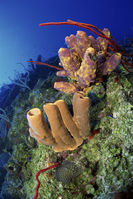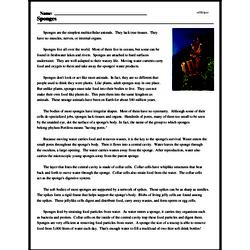Sponges
Sponges are the simplest multicellular animals. They lack true tissues. They have no muscles, nerves, or internal organs.
Sponges live all over the world. Most of them live in oceans, but some can be found in freshwater lakes and rivers. Sponges are attached to hard surfaces underwater. They are well-adapted to their watery life. Moving water currents carry food and oxygen to them and take away the sponges' waste products.
Sponges don't look or act like most animals. In fact, they are so different that people used to think they were plants. Like plants, adult sponges stay in one place. But unlike plants, sponges must take food into their bodies to live. They can not make their own food like plants do. This puts them into the same kingdom as animals. These strange animals have been on Earth for about 540 million years.
The bodies of most sponges have irregular shapes. Most of them have no symmetry. Although some of their cells do specialized jobs, sponges lack tissues and organs. Hundreds of pores, many of them too small to be seen by the unaided eye, dot the surface of a sponge's body. In fact, the name of the group to which sponges belong-phylum Porifera-means "having pores."




